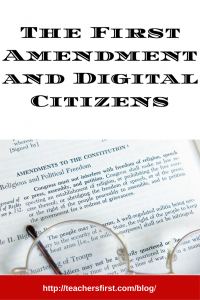 “Amendment I: Congress shall make no law respecting an establishment of religion, or prohibiting the free exercise thereof; or abridging the freedom of speech, or of the press; or the right of the people peaceably to assemble, and to petition the government for a redress of grievances.”
“Amendment I: Congress shall make no law respecting an establishment of religion, or prohibiting the free exercise thereof; or abridging the freedom of speech, or of the press; or the right of the people peaceably to assemble, and to petition the government for a redress of grievances.”
In these few, brief written words, the First Amendment protects so many of our cherished civil rights. However its interpretation has kept U.S. courts busy for 225 years as citizen groups actively defend them. As the school year begins, our rights guaranteed by the First Amendment continue to be topics of front page print news, online media reports, and the Tweets & Facebook postings of our social media friends.
Teaching our students about the First Amendment and how to navigate overwhelming amounts of information daily are part of the broader topic of media literacy. Media literacy education involves making sure our students are literate, no matter what the medium, and that they are good digital citizens in the use of technology to conduct their online lives. Just as our rights as American citizens come with responsibilities so do our rights as digital citizens.
When considering our individual rights, especially free speech and free press, the Center for Media Literacy definition says, “Media Literacy is a 21st century approach to education. It provides a framework to access, analyze, evaluate, create and participate with messages in a variety of forms — from print to video to the Internet. Media literacy builds an understanding of the role of media in society as well as essential skills of inquiry and self-expression necessary for citizens of a democracy.”
Thus, it is important to understand our digital citizenship rights and responsibilities. Digital Citizenship competencies are covered extensively in the International Society for Technology in Education’s Standards for Students. My favorite way of sharing what makes a good digital citizen is this infographic which provides an easy summary for middle grades and higher. Mike Ribble’s Nine Elements of Digital Citizenship emphasize students’ understanding of the responsibilities that come with freedom of speech. Ribble clarifies, “Basic digital rights must be addressed, discussed, and understood in the digital world. With these rights also come responsibilities as well. Users must help define how the technology is to be used in an appropriate manner. In a digital society, these two areas must work together for everyone to be productive.”
Teaching about the First Amendment, especially free speech and free press, is part of our school curriculum, especially at the secondary level. Here are some resources to involve your students and get them thinking critically and using their media literacy skills to better understand these concepts.
Media Literacy and Evaluating Online Information
- This handy chart from the Center for Media Literacy helps focus on the essential questions students should ask themselves to develop critical thinking when reading or viewing content in any medium: authorship, format, audience, content, purpose.
- This FactCheck.org post offers criteria on “How to Spot Fake News” which may be adapted for any grade level or medium
- The New York Times Learning Network Lesson Plan, “Evaluating Sources in a ‘Post-Truth’ World: Ideas for Teaching and Learning About Fake News,” has extensive information and ideas.
Federal Government Resources
The vast online content of the federal government is one of the best places to find teacher resources about the First Amendment to use as you discuss media literacy.
- The National Archives includes the primary documents and text of the First Amendment. The Archives’ DocsTeach site has many resources on all the amendments using primary sources, including:
- The First Amendment, Seeing the Big Picture, a Lesson Plan with primary sources,
- Putting the Bill of Rights to the Test: A Primary Source-Based Workbook, ebook.
- Federal Judiciary First Amendment Activities with high school level lesson plans using landmark court, and
- National Endowment for the Humanities Edsitement The First Amendment. K-12 Lesson plans and activities.
Organizations Dedicated to Helping Citizens Understand the First Amendment and Protecting Those Rights
- Bill of Rights Institute has lesson plans.
- The Newseum, the museum about journalism, has many resources about the First Amendment including a page dedicated to freedom of speech and a collection of lesson plans, Freedom in the Balance.
- C-Span Classroom has First Amendment lesson plans that include video.
Helpful Websites and Lesson Plans for the First Amendment
- Layers of Learning, a home schooling site, has content and activities for younger children.
- Free Speech Week, which is October 16-22 this year, provides ideas for how to include these concepts in your lesson plans.
- The Anti-Defamation League has lesson plans.
- 1 Amendment for All gives background information and helpful links.

